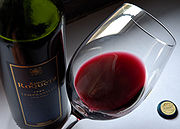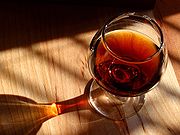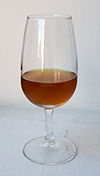
Wine color
Encyclopedia

Color
Color or colour is the visual perceptual property corresponding in humans to the categories called red, green, blue and others. Color derives from the spectrum of light interacting in the eye with the spectral sensitivities of the light receptors...
is also an element in wine tasting
Wine tasting
Wine tasting is the sensory examination and evaluation of wine. While the practice of wine tasting is as ancient as its production, a more formalized methodology has slowly become established from the 14th century onwards...
since heavy wines generally have a deeper color. The accessory
Wine accessory
A Wine accessory is generally any equipment that may be used in the storing or serving of wine. Wine accessories include many items such as wine glasses, corkscrews, and wine racks.-Wine glasses:...
traditionally used to judge the wine color was the tastevin, a shallow cup allowing to see the color of the liquid in the dim light of a cellar
Wine cellar
A wine cellar is a storage room for wine in bottles or barrels, or more rarely in carboys, amphorae or plastic containers. In an active wine cellar, important factors such as temperature and humidity are maintained by a climate control system. In contrast, passive wine cellars are not...
. The color is an element in the classification of wine
Classification of wine
The classification of wine can be done according to various methods including, but not limited to, place of origin or appellation, vinification methods and style, sweetness and vintage, or varietal used. Practices vary in different countries and regions of origin, and many practices have varied...
s.
Color origins
The color of the wine mainly depends on the color of the drupeDrupe
In botany, a drupe is a fruit in which an outer fleshy part surrounds a shell of hardened endocarp with a seed inside. These fruits develop from a single carpel, and mostly from flowers with superior ovaries...
of the grape variety. Since pigments are localized in the exocarp (skin) of the grape drupe, not in the juice, the color of the wine depends on the method of vinification and the time the must
Must
Must is freshly pressed fruit juice that contains the skins, seeds, and stems of the fruit. The solid portion of the must is called pomace; it typically makes up 7%–23% of the total weight of the must. Making must is the first step in winemaking...
is in contact with those skins, process called maceration
Maceration (wine)
Maceration is the winemaking process where the phenolic materials of the grape— tannins, coloring agents and flavor compounds— are leached from the grape skins, seeds and stems into the must. Maceration is the process by which the red wine receives its red color, since 99% of all grape juice is...
. Teinturier
Teinturier
Teinturier, a French language term meaning to dye or stain, is a wine term applied to grapes whose flesh and juice is red in colour due to anthocyanin pigments accumulating within the pulp of the grape berry itself. In most cases, anthocyanin pigments are confined to the outer skin tissue only, and...
grape is an exception in that it has also a pigmented pulp. The blending of two or more varieties of grapes can explain for the color of certain wines, like the use of Australian Rubired.
Red drupe grapes can produce white wine if they are quickly pressed and the juice not allowed to be in contact with the skins. The color is mainly due to plant pigments notably phenolic compounds
Phenolic compounds in wine
The phenolic compounds - natural phenol and polyphenols - in wine include a large group of several hundred chemical compounds that affect the taste, color and mouthfeel of wine. These compounds include phenolic acids, stilbenes, flavonols, dihydroflavonols, anthocyanins, flavanol monomers and...
(anthocyanidin
Anthocyanidin
Anthocyanidins are common plant pigments. They are the sugar-free counterparts of anthocyanins based on the flavylium ion or 2-phenylchromenylium, which is a type of oxonium ion . They form a large group of polymethine dye. In particular anthocyanidins are salt derivatives of the...
s, tannins ...). The color depends on the presence of acids in the wine
Acids in wine
The acids in wine are an important component in both winemaking and the finished product of wine. They are present in both grapes and wine, having direct influences on the color, balance and taste of the wine as well as the growth and vitality of yeasts during fermentation and protecting the wine...
. It is altered with the wine aging
Aging of wine
The aging of wine, and its ability to potentially improve wine quality, distinguishes wine from most other consumable goods. While wine is perishable and capable of deteriorating, complex chemical reactions involving a wine's sugars, acids and phenolic compounds can alter the aroma, color,...
by reaction between the different active molecules present in the wine, these reactions generally giving rise to a browning of the wine, leading from red to a more tawny color
Tawny (color)
Tawny is a yellowish brown color. The word means "tan-colored," from Anglo-Norman tauné "associated with the brownish-yellow of tanned leather," from Old French tané "to tan hides," from Medieval Latin tannare, from tannum "crushed oak bark," used in tanning leather, probably from a Celtic source...
. The use of a wooden barrel (generally oak barrels) in aging also affects the color of the wine.
Part of the color of a wine can be due to co-pigmentation of anthocyanidins with non pigmented other flavonoids or natural phenols (cofactors or “copigments”).
Rosé
Rosé
A rosé is a type of wine that has some of the color typical of a red wine, but only enough to turn it pink. The pink color can range from a pale orange to a vivid near-purple, depending on the grapes and wine making techniques.- Production techniques :There are three major ways to produce rosé...
wine is made by the practice of saignée or by blending a white wine with a red wine.
Color evolution
The presence of a complex mixture of anthocyaninAnthocyanin
Anthocyanins are water-soluble vacuolar pigments that may appear red, purple, or blue according to pH...
s and procyanidin
Procyanidin
Procyanidins are members of the proanthocyanidin class of flavonoids. They are oligomeric compounds, formed from catechin and epicatechin molecules....
s can increase the stability of color in wine.
As it ages, the wine undergoes chemical autoxidation reactions involving acetaldehyde
Acetaldehyde
Acetaldehyde is an organic chemical compound with the formula CH3CHO or MeCHO. It is one of the most important aldehydes, occurring widely in nature and being produced on a large scale industrially. Acetaldehyde occurs naturally in coffee, bread, and ripe fruit, and is produced by plants as part...
of its pigments molecules. The newly formed molecules are more stable to the effect of pH
PH
In chemistry, pH is a measure of the acidity or basicity of an aqueous solution. Pure water is said to be neutral, with a pH close to 7.0 at . Solutions with a pH less than 7 are said to be acidic and solutions with a pH greater than 7 are basic or alkaline...
or sulfite
Sulfite
Sulfites are compounds that contain the sulfite ion SO. The sulfite ion is the conjugate base of bisulfite. Although the acid itself is elusive, its salts are widely used.-Structure:...
bleaching. The new compounds include pyranoanthocyanin
Pyranoanthocyanin
The pyranoanthocyanins are a type of pyranoflavonoids. They are chemical compounds formed in red wines by yeast during fermentation processes or during controlled oxygenation processes during the aging of wine.-Examples:* Hydroxyphenyl-pyranoanthocyanins...
s like vitisins (A
Vitisin A (pyranoanthocyanin)
Vitisin A is a natural phenol found in red wines. It is a pyranoanthocyanin.-External links:*...
and B
Vitisin B (pyranoanthocyanin)
Vitisin B is a natural phenol found in red wines. It is a pyranoanthocyanin....
), pinotin
Pinotin
Pinotins are a type of pyranoanthocyanins, a class of phenolic compounds found in red wine. One such compound is pinotin A....
s and portosins and other polymeric derived pigments.
Castavinol
Castavinol
Castavinols are natural phenolic compounds found in red wines. These molecules are colorless and are derived from anthocyanin pigments. Thus their formation leads to a wine color loss.-External links:*...
s are another class of colorless molecules derived from colored anthocyanin
Anthocyanin
Anthocyanins are water-soluble vacuolar pigments that may appear red, purple, or blue according to pH...
pigments.
Colors


- red
- white (light colored wine)
- RoséRoséA rosé is a type of wine that has some of the color typical of a red wine, but only enough to turn it pink. The pink color can range from a pale orange to a vivid near-purple, depending on the grapes and wine making techniques.- Production techniques :There are three major ways to produce rosé...
(pinkish in color) - yellow (or straw color), see for instance vin jauneVin jauneVin jaune is a special and characteristic type of white wine made in the Jura wine region in eastern France. It is similar to dry fino Sherry and gets its character from being matured in a barrel under a film of yeast, known as the voile, on the wine's surface...
, a special and characteristic type of white wine made in the Jura wine region in eastern France, Jurançon or SauternesSauternes (wine)Sauternes is a French sweet wine from the Sauternais region of the Graves section in Bordeaux. Sauternes is made from Sémillon, Sauvignon Blanc, and Muscadelle grapes that have been affected by Botrytis cinerea, also known as noble rot. This causes the grapes to become partially raisined,... - Orange wineOrange wineOrange wine is wine made from white wine grape varieties that have spent some maceration time in contact with the grape skins. Typically white wine production involves crushing the grapes and quickly moving the juice off the skins into the fermentation vessel...
, a white wine that has spent some time in contact with its skin, giving it a slightly darker hue - TawnyTawny (color)Tawny is a yellowish brown color. The word means "tan-colored," from Anglo-Norman tauné "associated with the brownish-yellow of tanned leather," from Old French tané "to tan hides," from Medieval Latin tannare, from tannum "crushed oak bark," used in tanning leather, probably from a Celtic source...
, as in tawny port.
Other :
- Burgundy (color)Burgundy (color)Burgundy is a shade of purplish red associated with the Burgundy wine of the same name, which in turn is named after the Burgundy region of France. The color burgundy is similar to other shades of dark red such as maroon...
, a shade of purplish red - Sangria (color), a color that resembles Sangría wine
- Ox blood, probably referring to ancient practice of fining red wines with dry powdered blood
Scientific color determination
The International Organisation of Vine and WineInternational Organisation of Vine and Wine
The International Organisation of Vine and Wine is an intergovernmental organization which deals with technical and scientific aspects of viticulture and winemaking. The field of OIV includes grape production for all purposes, i.e...
(OIV) provides methods to assess the color of a wine using a spectrophotometer and the calculation of indices in the Lab color space
Lab color space
A Lab color space is a color-opponent space with dimension L for lightness and a and b for the color-opponent dimensions, based on nonlinearly compressed CIE XYZ color space coordinates....
.
See also
- Glossary of winemaking termsGlossary of winemaking termsThis glossary of winemaking terms list some of terms and definitions involved in making wine, fruit wine, and mead.-A:AcetaldehydeAcetic acidAcetificationAcetobacterAcidityActive acidity...
- Wine (color)Wine (color)At right is displayed the color wine.The color wine is a dark shade of red. It is a representation of the average color of red wine.The first recorded use of wine as a color name in English was in 1705.The source of this color is: ....
or "Burgundy", the color of red wine

